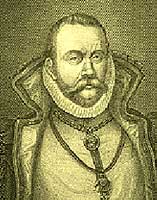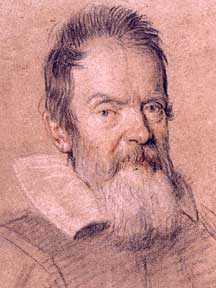ASTRONOMERS
RENAISSANCE
 TYCHO BRAHE (1546 A.D. - 1601 A.D.)
TYCHO BRAHE (1546 A.D. - 1601 A.D.)
Tycho Brahe was born in Denmark. He believed that the improvement of astronomy depended upon accurate observations. As a result, an observatory near Copenhagen was established, which became one of the finest observatories in Europe.
Brahe was the first astronomer to make corrections for atmospheric refraction (the change in direction of a ray of light as it passes from space into the atmosphere). As a result, a number of orbital anomalies never before noticed by other astronomers were made known by Brahe.
Brahe's contributions to astronomy were enormous. He designed and built new instruments, calibrated them and periodically checked their accuracy. An entire generation of young astronomers was trained by Brahe in the art of observing. Thus, he revolutionized not only astronomical instrumentation, but changed the practice of observing as well.
 COPERNICUS (1473 A.D. - 1543 A.D.)
COPERNICUS (1473 A.D. - 1543 A.D.)
Copernicus was, in fact, a church official but at heart just a student of math and science. After studying at the Universities of Kracow, Bologna, and Padua, Copernicus was appointed as a canon in the cathedral of Frauenberg by means of his uncle's influence.
His interest in astronomy grew until it became his main priority. Alone, Copernicus would use the naked eye to observe the sky. In 1530, Copernicus published his paper "De Revolutionibus," which laid an outline of his belief that the Earth rotates around the sun. Of course, Copernicus waited until he was dying to publish this so he could escape the sure punishment from the Catholic Church. It took the encouragement of George Rheticus, a 25-year-old German mathematics professor, to persuade Copernicus to publish his work. It wasn't just that the Church would punish him, but Copernicus was a perfectionist. He didn't want to publish something that he wasn't positive was true. He had been circulating summaries of his work among his friends, but he waited until 1543 (the year he died) to print the full work: On the Revolutions of the Heavenly Orbs.
Before Copernicus, the common assumption was that the sun and all the other planets rotated around the Earth, as Ptolemy had said in 150 A.D. No one had contradicted Ptolemy's idea since then, and the Catholic Church taught its lessons based on what Ptolemy had written. When Copernicus published his work, he was contradicting what the Church taught and thus was a heretic. Since Copernicus died before anything could be done to him, the worst punishment was that his book was placed on the Index (list of "naughty" books) in 1616 and wasn't removed until 1835. However, people who came later suffered by way of the Catholic Church, in particular Bruno and Galileo, who were both called before the Inquisition and charged with being heretics.
Copernicus placed the sun at the center of the universe simply because that was the most logical place for it. "In the center of everything the sun must reside; . . . there is the place which awaits him where he can give light to all the planets."
Copernicus' last book, published while he was dying, proposed the heliocentric theory that places the sun at the center of the universe. He organized the five planets that were known at that time in the order that we know they are in today: Mercury, Venus, Earth, Mars, Jupiter, Saturn. The moon orbits around the Earth, he stated, but the stars are distant and don't revolve around the sun. Since the Earth rotates around its own axis, the stars appear to revolve around the Earth in the opposite direction.
This idea of a sun-centered system had actually already been proposed by Aristarchus of Samos around 200 B.C. However, Aristotle's influence overpowered Samos' observations. Aristotle asked: (1) If the Earth spun on an axis, why didn't objects fly off?; (2) If the Earth was moving (around the sun), why didn't it leave behind the birds flying in the air?; (3) If the Earth was orbiting the sun, why didn't the stars appear to change their position since they were being viewed from a different perspective (called parallax)? The first two have no scientific backing, but the third objection is countered by the finding that the stars are very far away from us (we have the small parallax angle of the image above), and the amount of parallax is so small at that distance that it is only measurable with special instruments.
 GALILEO (1564 A.D. - 1642 A.D.)
GALILEO (1564 A.D. - 1642 A.D.)
Whoever told you that Galileo invented the telescope was wrong. First things first: Galileo saw the telescope in Holland and just made a replica. However, Galileo is much more important to history than just a telescope thief. He discovered the moons of Jupiter, backed up Copernicus' theory, and even developed the modern approach to science through The Scientific Method.
Galileo Galilei was an Italian physicist and astronomer. Born February 15, 1564, in Pisa, his father Vincenzo Galilei wanted Galileo to become a doctor. In 1581, Galileo attended the University of Pisa with the intent to study medicine after his father's desire. While there, Galileo discovered his talent in math and left to become a tutor. He later became a professor of mathematics.
Galileo is famous for bringing the telescope to Europe. Also, the same year (1609), he looked at the moon through a telescope and discovered it was mountainous and pitted. He also turned this device on the four moons of Jupiter, the planet Saturn, Venus and its phases, and the sunspots of the sun.
Galileo was a strong believer in Copernicus' theory that the Earth actually revolves around the sun. His findings, such as the moons that orbit Jupiter, were strong evidence that this was the correct theory. However, the Catholic Church didn't agree and chose to believe that the Earth was the center of the universe. That was how everything fit together in accordance with how they interpreted the Bible. When Galileo was around, the Catholic Church had a huge influence in society. So, when Galileo published papers that said that the universe is heliocentric (centered on the sun), he was brought up against the Inquisition. He was accused of being a heretic (in 1616) for opposing the Church's teachings. He was then cleared of the charges but was told to keep quiet. Despite these obstacles, Galileo published a book in 1632 that indirectly supported the heliocentric theory. He was again called before the Inquisition and was found guilty of heresy in 1633, with the punishment of life imprisonment. Galileo was forced to recant what he had said and then placed under house arrest because of his age. He then continued working and experimenting until his death on January 8, 1642.
 JOHANNES KEPLER (1571 A.D. - 1630 A.D.)
JOHANNES KEPLER (1571 A.D. - 1630 A.D.)
Kepler, a German astronomer, was the first supporter of the heliocentric theory of Copernicus. In addition, he developed the three laws of planetary motion. In 1596, Kepler published Mysterium cosmographicum (Cosmographic Mystery) in which he defended the Copernican theory, as well as detailing his beliefs concerning the structure of the planetary system. Years later, his Epitome astronomiae Copernicanae (Introduction to Copernican Astronomy, 1618 - 21) became one of the most widely read treatises on astronomy in Europe.
Kepler's scientific legacy was legendary at the time and continues to this day. He accurately determined many planetary positions, especially Mars. He conducted intensive studies of the true orbits of the planets, abandoning the ancient belief that the planets must move in perfect circles. He proved that the orbit of Mars is an ellipse with the sun occupying one of its two foci. This was Kepler's first law of planetary motion, (New Astronomy, 1609) along with his second law of areas that govern planetary velocity. His third law was published 10 years later, which showed a relationship between the orbital periods and the distance of the planets from the sun.